Nonprofit marketers know that capturing potential donors’ attention is paramount to fundraising success. While digital marketing and automation has opened new opportunities to reach audiences, breaking through the clutter without breaking the bank is increasingly difficult. With the right approach, incorporating direct mail fundraising can help nonprofits economically achieve their goals with measureable results.
Maximizing the return on investment (ROI) of your direct mail campaign is easier than it may seem. Working with several organizations of all sizes and demographic reach in recent years to implement their nonprofit fundraising strategies, we’ve developed a set of recommended best practices for designing and executing successful campaigns.
Personalize the message
You have a list of stakeholders and donors, but does their recent giving activity align with how you communicate to them? Some extra legwork to target your messages according to giving history and personal preferences can go a long way toward maximizing your direct mail marketing efforts.
For example, rather than sending the same mailing to your entire list, create separate mailings for donors at various levels of giving. Give them a reason to consider increasing their donations, or to start donating to your organization. A one-size-fits-all approach to direct mail fundraising, or any marketing campaign, won’t break through to today’s information-overloaded audiences.
Make your story matter to donors
Remember, you are asking people to separate themselves from their hard-earned money. It’s no easy task for donors or for you, so providing compelling reasons for them to give to your organization is paramount.
It’s easy to state your case based on your organization’s mission statement or core values. However, connecting your needs to donors’ sense of giving with facts or real life examples and a strong call to action can give your campaign an extra boost and build stronger long-term donor relationships.
Get Ai's 2024 USPS Mailing Guide
Make your campaign as seamless as possible
No matter how you reach potential donors, it’s important to give them options to correspond with your organization. Give them multiple options to connect, including mail, email, social media or a microsite designed for your campaign.
Remember that today’s on-the-go donor is increasingly likely to make a digital connection on their mobile device, so design your assets accordingly – including direct mail pieces – to make that mobile connection as easy as possible, including using QR codes.
Mix it up
Now that you’ve set up online and offline options for potential donors to connect with your organization, don’t forget to use those channels for proactive nonprofit fundraising outreach and content management and distribution. It’s important to take a multi-channel approach, as different audiences prefer varying methods to consume your message.
In fact, as brands have steered more of their marketing spend to digital with email, online ads and social media in recent years (including efforts to reach the coveted millennial audience), the response rates for those mediums has suffered.
According to the DMA’s 2016 Response Report*, response rates for direct mail campaigns using house lists average 5.3 percent, while cold lead/prospect lists can expect a 2.9 percent response rate. No other channel, including online display ads, email, social media and paid search, yields even a one percent rate.
That’s not to say digital marketing shouldn’t be part of your strategy. The key is to ensure it works in tandem with your print marketing to reap the benefits of both.
Test, measure, and modify your campaigns
Now that your print and digital communications tactics are in place, don’t make the mistake of assuming some or all of them will work. As noted above, your segmented audiences respond to various messages differently and prefer an array of ways to consume information.
Measure your response rates and donor behaviors, such as how much and how often different audience segments make a donation or attend an event after receiving a direct mail fundraising piece or digital marketing message. Then, tweak your approach accordingly. You’ll likely find that you can segment your lists even further and approach donors according to their preferences.
With a sound understanding of your audiences, properly segmented lists and a multi-channel approach, your nonprofit donor campaigns can benefit greatly from a well-planned direct mail fundraising strategy.
* The 2016 DMA Response Rate Report
CONTACT US to speak with a Marketing Implementation Solutions expert.
Comments are closed.


